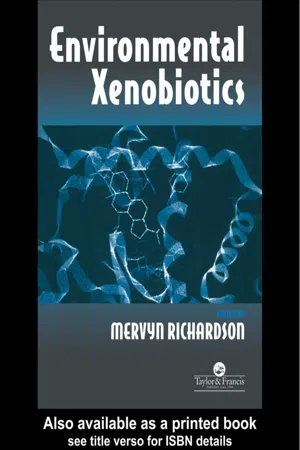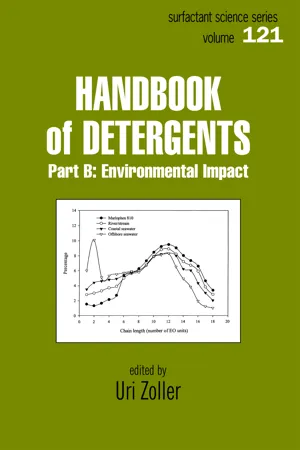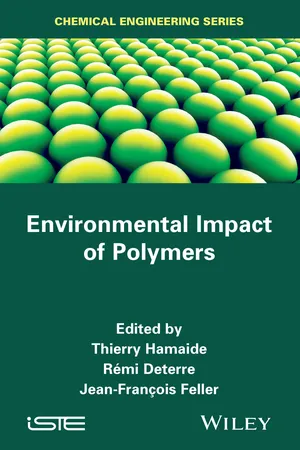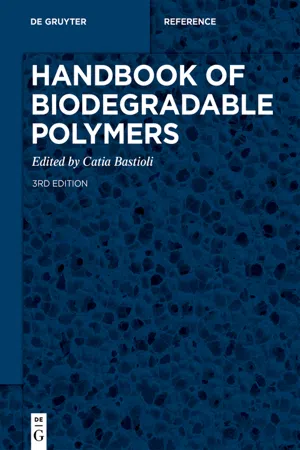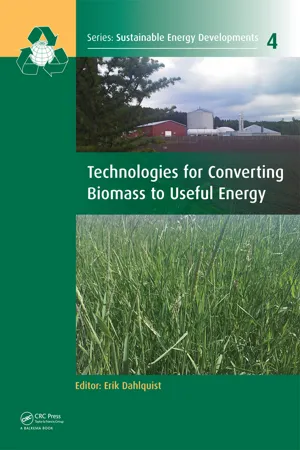Chemistry
Biodegradability
Biodegradability refers to the ability of a substance to be broken down by natural processes, such as bacteria or other living organisms, into simpler, non-toxic compounds. In the context of chemistry, this property is important for assessing the environmental impact of various materials and chemicals. Biodegradable substances can be beneficial for reducing pollution and minimizing waste accumulation.
Written by Perlego with AI-assistance
Related key terms
1 of 5
10 Key excerpts on "Biodegradability"
- eBook - ePub
First Do No Harm
A Chemist's Guide to Molecular Design for Reduced Hazard
- Predrag V. Petrovic, Paul T. Anastas(Authors)
- 2023(Publication Date)
- Jenny Stanford Publishing(Publisher)
Chapter 3 Degradability3.1 What Is the Difference Between Degradability and Biodegradability?
The degradability of a chemical substance is the capability of the said chemical to decompose under certain conditions. In nature, most substances and molecules are not permanently stable but, given enough time and right conditions can decompose into smaller and chemically distinct fragments. There are two main ways this can happen, either under the influence of different environmental conditions, i.e., abiotically; or by the work of microorganisms, i.e., biotically (see Fig. 3.1 ).1 Abiotic degradation will cause chemical decomposition of molecules when they are exposed to sufficient heat (thermolysis), light (photolysis), or water (hydrolysis).2 The conditions and specifics for each of these processes will be discussed in the following sections. While the chemicals can decompose without the influence of any microorganism, once they get into the environment a large number of species of bacteria, fungi, and yeasts can absorb and transform these chemicals.Figure 3.1 Schematic representation of different kinds of degradation.The Biodegradability of chemical compounds depends not only on their molecular structure and physicochemical properties but also on the broad range of conditions existing in the environment they are exposed to. These include the presence of different microorganisms, the existence of adequate nutrients for the microbial population, concentration of the chemical, temperature, pH, and covalent binding of the chemical to other substrates in the environment (e.g., humus, clay). Obviously, some of these factors are not as important from the molecular design perspective since they cannot be modified actively. Generally, a higher temperature (within the normal environmental condition) will promote biodegradation, as well as a nutrient-rich environment, but these cannot be influenced by better design. On the other hand, water-soluble molecules are generally better biodegraded, though many microorganisms secrete their own biosurfactants, increasing the solubility rate of the lipophilic molecules.3 - eBook - PDF
- Mervyn Richardson(Author)
- 1996(Publication Date)
- CRC Press(Publisher)
The term primary degradation was adopted in a period when detergent legislation were being promulgated, and has been losing its dominance with the advent of legislation on chemicals. Partial degradation cannot be considered environmentally sufficient since any ensuing stable metabolites may be accumulated in the environment. Biodegradability can be assessed in terms of its purpose and in terms of its conditions. Classification of chemicals into biologically degradable and non-degradable compounds is both relative and inaccurate. One should in each case specify the conditions under which no biological degradation was (or was not) proved. Apparently, biologically non-degradable compounds are usually in fact more slowly degradable, or their degradability can be enhanced by selecting suitable microorganisms. Basically, there are no substances which would be entirely biologically non-degradable. The degradation may be so slow that, in terms of self- purification in streams, biological treatment of waste waters and the behavior of chemicals in dumps, it is virtually negligible (eg humic substances, lignin sulfonates, synthetic polymers). There are two approaches to the evaluation of Biodegradability: microbiological and environmental. The microbiological approach is usually based on experiments with pure bacterial cultures for which optimum conditions are sought and whose metabolism is studied. However, these conditions differ from those prevailing in natural environment and the ensuing data therefore cannot be used directly for predicting the actual behavior of chemicals in the environment. The degradability data resulting from this approach are usually overestimated. However, the results of these experiments have their practical importance for biological removal (bioremediation) of accidental pollution of groundwaters or soil, which is usually performed with pure bacterial cultures. - eBook - PDF
Handbook of Detergents, Part B
Environmental Impact
- Uri Zoller(Author)
- 2004(Publication Date)
- CRC Press(Publisher)
Examples of environmental variables controlling the rate and extent of Biodegradability include oxygen concentration, water content of soils, temperature, and the availability of organisms capable of degrading the given substance. Some substances, as a result of other properties of the molecule (steric hindrance etc.) will not degrade under any conditions; other sub-stances require a very special environment, and yet others can be freely utilized (degraded) by living organisms. There are abiotic mechanisms by which a substance can degrade in the environment, such as photolysis (OECD, 1997) and hydrolysis. Ingredients may, in or after use, form different salts from those in which they were 249 formulated (thus a sodium salt in use may become a calcium salt after use), modifying the chemical and physical behavior of the substance, for example, in terms of solubility. All of these factors should be considered when examining the degree of persistence of substance (see Section V.C) in the environment. Note that it is the substance , not the product or formulation, that should be the subject of discussions of degradation. To the environment the concept of a product has no relevance. The product has lost its integrity the moment it is used or accidentally reaches the environment. The ingredients of a product each go their own way, according to their physical properties (solubility, volatility, degradability, etc.). Statements about the Biodegradability of a product, tested as a whole, are generally meaningless and can be seriously misleading. A claim such as ‘‘99% biodegraded’’ should be regarded with little comfort without knowing the identity and properties of the remaining 1% of the mixture. II. USES OF Biodegradability DATA Degradability of man-made substances is generally a property that is undesirable, at least until they have performed the functions for which they were designed. - eBook - ePub
- Thierry Hamaide, Rémi Deterre, Jean-François Feller, Thierry Hamaide, Rémi Deterre, Jean-François Feller(Authors)
- 2014(Publication Date)
- Wiley-ISTE(Publisher)
14
Biodegradability and/or Compostability?
14.1. Biodegradation
14.1.1. Introduction
All organic materials, based on the chemistry of organic carbon, can be gradually degraded by diverse pathways (physical, chemical and biological) until they are reduced to molecules as simple as water, carbon dioxide, methane and various inorganic compounds (nitrogen, phosphorous, sulfur, etc.), initial constituents of organic matter. In this respect, we can say that all organic materials are biodegradable, provided that they have sufficient time to degrade: from several days to several weeks for starch, from several weeks to several months for PBAT or PHA, and several hundred years for PET or PE.From an environmental point of view, to prevent accumulations and dispersions of particles, it is attractive to use polymers whose end of life is characterized by a rapid biodegradation.The “accurate” measurement of the speed and degree to which a material biodegrades1 is still very controversial. The only way to remain impartial is to refer to standards determined from laboratory research.14.1.2. The definitions of biodegradation
There are many definitions of biodegradation, all of which include the same main principles.According to the French norm NFU 52001 Biodegradable materials in agriculture and horticulture – mulching films – AFNOR 2005 , the definition of biodegradation is as follows:The biodegradation of a material occurs via the succession of concomitant physical, chemical and biological phenomena, in all cases leading to the reorganization of biomass and the release of CO2 (and/or CH4 ), water, energy (in the form of heat), eventually producing new organic molecules and possible inorganic residues.The “guide to vocabulary in the domain of degradable and biodegradable polymers and plastics. CEN/TR 15351:2006 - eBook - ePub
- Catia Bastioli(Author)
- 2020(Publication Date)
- De Gruyter(Publisher)
The overview presented above makes clear that there is no such thing as a single optimal method for determining the biodegradation of polymeric materials. First of all, the biodegradation of a material is not only determined by the chemical composition and corresponding physical properties, but the degradation environment, to which the material is exposed, also affects the rate and degree of biodegradation. Furthermore, the method or test to be used depends on what information is requested; especially as the biodegradation concept is very important in relation to the end of life of a material, while it could be just one aspect of health and environmental safety in other cases.It is fairly obvious, but often neglected, that one should always consider why a particular polymeric material should be (or not be) biodegradable when contemplating how to assess its Biodegradability. After all, it is the intended application of the material that governs the most suitable testing environment, the parameters to be measured during exposure and the corresponding limit values. For example, investigating whether biodegradation of a plastic material designed for food packaging could facilitate undesired growth of (pathogenic) microorganisms requires a completely different approach from investigating whether its waste can be discarded via composting (i.e., whether it degrades sufficiently rapidly to be compatible with existing biowaste composting facilities).It is important to state that it will not be sufficient to ascertain macroscopic changes, such as weight loss and disintegration, or growth of microorganisms, to define a material as biodegradable because these observations may originate from a partial biodegradation or from the degradation of a component of the material itself. In order to study the real biodegradation of a material in the environment (composting, anaerobic digestion, soil and water) it is necessary to determine the mineralisation, which is the transformation of the material into: CO2 , CH4 - eBook - PDF
Engineering Tools for Environmental Risk Management
2. Environmental Toxicology
- Katalin Gruiz, Tamas Meggyes, Eva Fenyvesi, Katalin Gruiz, Tamas Meggyes, Eva Fenyvesi(Authors)
- 2015(Publication Date)
- CRC Press(Publisher)
86 Engineering Tools for Environmental Risk Management – 2 – Toxicity (mg/L) ◦ acute hazardous effect L(E)C 50 ≤ 1 ◦ chronic hazardous effect NOEC ≤ 0.1. The regulations also suggest that, in addition to toxicity, the environmental fate properties, first of all Biodegradability, determine the environmental risk of chemicals and their categorization as PBT. 3.1.2 Biodegradation – definitions Before introducing the biodegradation measurement methods, some terms must be clarified in connection with biodegradation of chemicals. Biodegradability or more precisely a chemical’s potential to be degraded by bio-logical systems is an intrinsic material characteristic, which depends on the chemical structure and molecular mass of the chemical substance. Biodegradation is the biological decomposition or breakdown of a substance. The term is mainly used for the action of environmental microorganisms such as bacteria or fungi. Biodegradation is affected by both the chemical substance’s structure and resistance to biodegradation and the biological activity of microorganisms, or the com-munity of microorganisms in the environment, which can be highly diverse depending on climate, season and the adaptive character and behavior of the degrading commu-nity. The presence of other chemicals is another influencing factor. Mineralization is distinguished by biodegradation: it denotes the natural process of complete biodegra-dation in which organic matter is fully degraded under aerobic or anaerobic conditions. As a result, gaseous or water-soluble inorganic residues of H 2 or H 2 O are produced from all reduced organic molecules, C or CO 2 from organic carbon, NH 3 or NO − 3 from nitrogen-containing organic molecules, PO 3 − 4 from phosphorous-and S 2 − , SH − or SO 2 − 4 from sulfur-containing biomolecules, and positive or negative ions from all kinds of metals, originally contained in living or dead organic matter. - eBook - ePub
Biodegradable Polymers
Materials and their Structures
- Manjari Sharma(Author)
- 2021(Publication Date)
- CRC Press(Publisher)
The terms ‘biodegradation’ and ‘compostability’ are very common but are frequently used. In biodegradation, the enzymes of the biosphere essentially take part at least in one step during cleavage of the chemical bonds of the material. Notably, biodegradation does not ensure that a biodegradable material will always degrade. In fact, degradation will only occur in a favourable environment, and the biodegradable material will not necessarily degrade within a short time. It is, therefore, important to couple the term biodegradable with the specification of the particular environment where the biodegradation is expected to happen, and of the timescale of the process.Some commodity plastics can be degraded at every stage of production in both the stabilized and unstabilized form and also undergo very slow biodegradation. It is now well evident that polymer/plastics waste management through biodegradation or bio-conversion is the most suitable solution for ‘Plastic Waste Management’ among the other traditional methods like Incineration, Pyrolysis, Land filling etc.Several means [1 -4 ], have been used to achieve the Biodegradability/bio-deteriobility/Photo-Biodegradability in polymers. There is a group of commercial biodegradable polymer representing combination of polymers from different origins. They have been formulated in such a way, so as to, offer interesting properties limiting the amount of costly materials in their composition. These materials are known as “environmentally acceptable degradable plastics” [5 ]. During their exploitation, these materials display a behaviour similar to that of conventional synthetic polymers. When their service time comes to an end, they are capable of degrading to low molecular weight compounds as a result of the combined action of different environmental agents-biological, chemical, and physical.In agreement to above standards, the said degradation should lead to carbon dioxide, water, and cellular biomass in quantities similar to those of the natural biodegradable polymers, without the formation of permanent or toxic residues. Consequently the biodegradation definition must consider not only the degree of biodegradation, but also the impact of the polymer by-products on the environment.Polysaccharides have been used more frequently as natural fillers for this purpose and well investigated by Griffin and Bastioli particularly in polyolefins at fairly low concentrations. The major problem is incompatibility between hydrophilic polysaccharides and generally the hydrophobic nature of polymer matrix where the complex mechanism of coupling through coupling agents, morphology of interfaces, surface energy and wetting phenomenon considerations are also necessary [6 - Robin Smith(Author)
- 2005(Publication Date)
- Woodhead Publishing(Publisher)
30,41 The earliest test methods for the biodegradation of plastics followed from the use of biological oxygen demand (BOD) that had originally been developed to evaluate the environmental persistence of synthetic detergents that were the cause of pollution in inland waterways during the 1950s. More recent standard test methods for water quality have been comprehensively reviewed together with their subsequent application to the biodegradation of plastics. 33 The main critical parameters proposed by the International Standards Organisation (ISO) are either oxygen absorption 49 or carbon dioxide evolution 50 in the presence of microorganisms. The latter procedure was taken over directly by the European Standards Organisation (CEN) in EN 13432. 51 However, low molar mass chemicals are quite different from plastics. The first evidence of physical deterioration of plastics is generally due to abiotic chemical processes, which commence at an early stage during exposure to the environment. Consequently the measurement of mechanical properties is an important indicator of degradation, although not necessarily of biodegradation. It is argued with some justification that these changes alone do not guarantee that the residues are eventually harmless to the environment. In principle, complete mineralisation of biodegradable plastics by biometric means is the most convenient way of demonstrating the extent of biodegradation. In practice the end of the induction period is the point at which biodegradation begins and this in turn is determined by the post treatment the Standards for environmentally biodegradable plastics 323 polymer receives during or after its service life, for example, during composting for packaging plastics or during outdoor weathering for agricultural products. The durability of degradable plastics before the end of their useful life is of great importance to manufacturers of packaging and agricultural products such as mulching films (Ch. 17).- eBook - PDF
Technologies for Converting Biomass to Useful Energy
Combustion, Gasification, Pyrolysis, Torrefaction and Fermentation
- Erik Dahlquist(Author)
- 2013(Publication Date)
- CRC Press(Publisher)
The influence of Biodegradability on the anaerobic conversion of biomass 329 Alternatively, when the chemical composition of the substrate is known, f D can be calculated from the ratio of observed to theoretical specific biomethane yields ( SMY ): f D = B o B u (12.5) The theoretical SMY ( B u ) of a generic substrate (i.e. C n H a O b N c ) can be derived from the stoichiometric formula developed by Symons and Buswell (1933): C n H a O b N c + n − a 4 − b 2 + 3 c 4 H 2 O → n 2 − a 8 + b 4 + 3 c 8 CO 2 + n 2 + a 8 − b 4 − 3 c 8 CH 4 + c NH 3 (12.6) Lastly, when chemical oxygen demand ( COD ) data are available, f D can be obtained by the ratio of biodegradable to total COD : f D = COD D COD T (12.7) where COD D is the biodegradable chemical oxygen demand [g/L], and COD T is the total chemical oxygen demand [g/L]. COD D can be calculated from the theoretical 350 L of biomethane yielded (at STP ) per kg of COD stabilized (McCarty, 1964), and using B o as obtained from the BMP assay. COD T can be determined analytically (APHA, 1995), or theoretically, from the chemical composition of the substrate and the stoichiometry of oxidation-reduction reactions. 12.3 FACTORS LIMITING SUBSTRATE Biodegradability Most organic substrates are made up of a mixture of carbohydrates, proteins, and lipids. During anaerobic digestion, these composite materials undergo a series of chemical transformations, where methane and carbon dioxide are the main gas products (Fig. 12.4). In the first step, the organic/biodegradable fraction of polymers is hydrolyzed to soluble products via extracellular enzymes that allow their passage across the cell membrane. Once in the cell, sugars, amino acids, and long-chain fatty acids are fermented (or oxidized, in the latter case) to volatile fatty acids, alcohols, carbon dioxide, hydrogen, as well as nitrogenous and sulfurous compounds. With the exception of acetate, volatile fatty acids are converted to additional acetate, hydrogen, and carbon dioxide. - Abhilash, B. D. Pandey, K. A. Natarajan(Authors)
- 2015(Publication Date)
- CRC Press(Publisher)
537 20.6 Bistability of Microbial Processes ............................................................ 539 20.6.1 Mechanism of Bistability under Formation of Partial Oxidation Products ........................................................................ 539 20.6.2 Bistability under Biodegradation of Toxic Compounds ........... 542 20.6.3 Bistability of Mixed Substrate Utilisation .................................. 544 20.7 Conclusion .................................................................................................. 546 References ............................................................................................................. 546 528 Microbiology for Minerals, Metals, Materials and the Environment the purpose with microorganisms and their communities with protozoa and other organisms may be more eco-friendly (Senthilvelan et al. 2014; Whiteley and Bailey 2000). The degradation of contaminants, including recalcitrant and toxic compounds, by microorganisms is at the core of nat-ural mineralisation of organic compounds in the biosphere. In such pro-cesses, the probability of accumulating dangerous by-products is almost negligible. Man-made biotreatment of organic wastes essentially differs from natural mineralisation processes. This is connected with very high concentrations of compounds subject to disposal with the necessity to process wastes in much less time. Besides, differences in waste bioprocessing are due to their pecu-liar and complex composition specific for each production. For example, pet-rochemical and coke-chemical plants produce large volumes of wastewaters containing a broad spectrum of hydrocarbons, including mono- and polycy-clic aromatic compounds, cyanides and ammoniacal and other compounds (Jena et al. 2005). The volume of wastewater in synthetic resin production is much smaller, but it contains critically high concentrations of phenol, form-aldehyde and methanol (Urtiaga et al. 2009).
Index pages curate the most relevant extracts from our library of academic textbooks. They’ve been created using an in-house natural language model (NLM), each adding context and meaning to key research topics.

